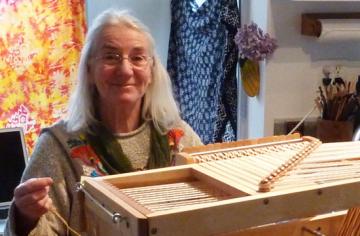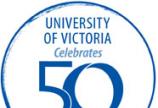Pioneer of educational technology at UVic shares her story
- Clarke Duggan

Three decades ago, computing students at UVic didn't use computers—they used pencils, paper and what were known as “punch cards”– pieces of paper in which holes represented digital information. However, those olden days are long gone, and UVic has since become one of Canada’s leading centers for digital scholarship. This transformation didn’t happen overnight. For more than two decades, Laura Proctor, a woman with a vision, worked behind the scenes, teaching UVic’s faculty and staff how to incorporate new technologies into their research and instruction.
Laura still remembers the differences in education when her career kicked off in 1979. “There was no technology in the classroom other than overhead projectors. Even as a programmer, the idea that you could have a computer in your classroom didn’t exist.”
But changes were happening whether people realized it or not. More and more UVic faculty and staff needed to know how to use these new technologies, which is where Laura came in. “There are a million and one tools for teachers to use, but someone had to show them how to use them,” she says.
Originally a lab instructor for math students, Laura quickly took over the Consultant’s Office in 1981 and later went on to found the Computer Help Desk, which she ran until 1987. Along with the rapid evolution of computing technology, the Help Desk quickly became so big that it was impossible for one person to run on her own. “Business was booming,” she said. “People from math and sciences, people from English, people from virtually every faculty needed help just to keep up.”
Within a few years, her influence spread throughout the campus, and she became everyone’s go-to person for technical help. “All sorts of people used to come in and say ‘If I wanted to do this how would I do it?’ and then I would say, ‘Well you can try this’ and point them in the right direction.”
Her Help Desk began as a place for people to find a solution to buggy programs or other technical difficulties. However, she quickly began giving workshops for teachers on how to incorporate new technologies into their classrooms, explaining how online bulletin boards or course websites could help them and their students, and how students could have engaging discussions online.
Looking back on her career, she notes that engagement was one of the biggest challenges she faced. “You have to have a carrot. At the beginning, there has to be something in it for everybody. And that was my role.”
She was a true visionary and one of the few who saw the potential of internet technology in the classroom. “Did people see computing as the future? No. Most people wouldn’t have seen it in their everyday lives.” This led to a certain amount of scepticism, and Laura appreciates this challenge as part of what made her career at UVic so meaningful. “There were a lot of people who thought, ‘Oh well, this is just silly; new technology for the sake of technology,’” she says, “But that’s what I loved about my life at UVic—there was a lot of interaction with a lot of interesting people.”
Laura took a break from teaching in 1990 and travelled throughout China. When she returned five years later, the university had undergone a major transformation. “The school got bigger and bigger,” she said. “Socially, UVic was a very tight community in 1989 where you knew everyone and if you didn't like something you could go straight to a dean or vice-president.”
While she was away, however, UVic had become a bigger and more ambitious university. Enrolment had gone up, there were more buildings, more teachers, and it wasn’t one big family anymore. “This was one of the most significant personal challenges for me. It used to be a warm cosy place, but it became a big institution, a business, and became more successful.”
Although no longer running the Help Desk, Laura nevertheless remained at the leading edge of educational technology. After 1995, she continued to provide support for faculty and staff through workshops and troubleshooting; she taught applied skills for computational linguistics; coordinated the introduction of WebCT and continued to provide training and support for the use of web-based projects until 2009 when she retired.
“I had a hugely interesting career. Internet technologies were rapidly changing, and I was lucky enough to ride this wave until a few years ago when I stepped off.”
Reflecting on her time spent at UVic, Laura says running and organizing the Help Desk led to some of her most memorable experiences. “I suppose if I wanted to be remembered for anything, it was for helping people,” she says. “I always felt my job was to be a mentor to others.”
The shape of education is still changing, and Laura sees new technologies as an important part of this change. “The future of UVic will depend on how well the institution adapts to online and open education. I do believe that the future in general will belong to those who share, collaborate and cooperate rather than those who compete and hoard. We are in an era of plenty and the point is to share it around.”
Laura was one of a handful of women working in the field of computer technology when she first started the Help Desk, and the foundation she laid helped the current generation of students and teachers create some of our school’s most impressive pieces of digital scholarship. Michael Best’s Internet Shakespeare Editions, John Lutz’s Great Unsolved Mysteries in Canadian History, and future projects would not have been possible without Laura Proctor–a true pioneer of educational technology at UVic.


